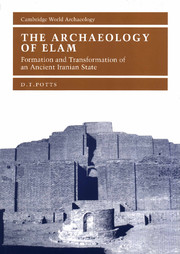Book contents
- Frontmatter
- Contents
- List of illustrations
- List of plates
- List of tables
- Preface and acknowledgements
- List of abbreviations
- Note on transliteration and dating systems
- 1 Elam: what, when, where?
- 2 Environment, climate and resources
- 3 The immediate precursors of Elam
- 4 Elam and Awan
- 5 The dynasty of Shimashki
- 6 The grand regents of Elam and Susa
- 7 The kingdom of Susa and Anshan
- 8 The Neo-Elamite period
- 9 Elam in the Achaemenid empire
- 10 Elymais
- 11 Elam under the Sasanians and beyond
- 12 Conclusion
- References
- Index
2 - Environment, climate and resources
Published online by Cambridge University Press: 22 September 2009
- Frontmatter
- Contents
- List of illustrations
- List of plates
- List of tables
- Preface and acknowledgements
- List of abbreviations
- Note on transliteration and dating systems
- 1 Elam: what, when, where?
- 2 Environment, climate and resources
- 3 The immediate precursors of Elam
- 4 Elam and Awan
- 5 The dynasty of Shimashki
- 6 The grand regents of Elam and Susa
- 7 The kingdom of Susa and Anshan
- 8 The Neo-Elamite period
- 9 Elam in the Achaemenid empire
- 10 Elymais
- 11 Elam under the Sasanians and beyond
- 12 Conclusion
- References
- Index
Summary
The approximate geographical boundaries of Elam are set out in this chapter, and the topographic and environmental zones within those boundaries are described. The reader is introduced to the climate, rainfall and hydrology of the relevant portions of Fars, Khuzistan and Luristan in south-western Iran. Evidence for differences between the climate of the past and that of the present is examined and in that context the possibility of anthropogenic changes to the Elamite landscape is raised. Finally, the animal, mineral and vegetable resources of the region are surveyed, showing just what earlier inhabitants of southwestern Iran had at their disposal.
Introduction
It is important in any regional archaeological or historical study to have an appreciation of what the climate, environment, land-use potential and natural resources of the region under study (Fig. 2.1) were like by the start of the period in which one is interested. Although the geographical limits of Elam changed through time, we shall consider the Elamite area at its greatest extent to have extended from Kermanshah province in the northwest to the eastern border of Fars in the southeast. For the sake of convenience we shall take as the region's northern boundary the ‘Royal’ or ‘Great Khorassan’ Road leading from Baghdad in the west to Kermanshah, Kangavar and Hamadan (and eventually Qazvin and Teheran) in the east.
- Type
- Chapter
- Information
- The Archaeology of ElamFormation and Transformation of an Ancient Iranian State, pp. 10 - 42Publisher: Cambridge University PressPrint publication year: 1999



